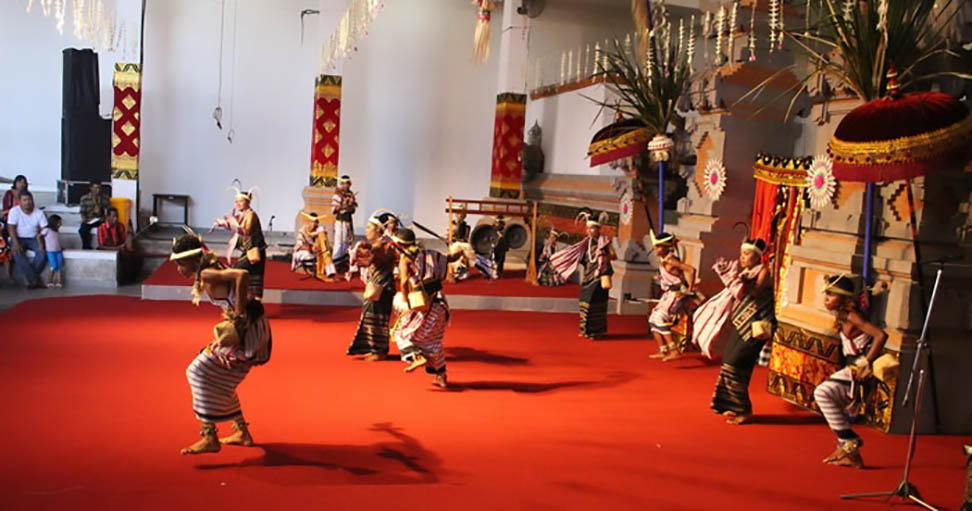Hedung Dance, Traditional Dances From NTT
Hedung dance is one of the traditional dances of a kind of Adonara public war dance, East Flores, NTT Province. This dance is performed by the dancers both men and women by using clothes and weapons of war. In this dance performance, they dance with movements depicting a heroic soul of the Adonara people on the battlefield. Hedung dance is one of the traditional dances are quite famous and often displayed in various events such as the event welcoming important guests, traditional events, and cultural festivals.
Historically, in ancient times in Adonara there was often a war between the tribes and between villages. Before they leave for the battlefield, they will gather to perform the Hedung Dance and a ritual to be given salvation for those who will go to war. It is also done when they come home from the battlefield, the dancers will welcome the heroes with Hedung Dance. The name hedung itself is taken from the word hedung, which can mean win. So it can be interpreted that Hedung Dance is a victory dance.
As explained earlier, Hedung Dance was originally just a war dances and part of the rituals of the Adonara people in escorting and welcoming the heroes of the battlefield. But with the development of the times, the function is then changed and has a different meaning. At this time Hedung dance interpreted by the people of Adonara as a tribute to the ancestors. In addition, this dance is also to introduce and remind to the young generation of tradition, culture, and heroic souls on their ancestors first.
In the show, Hedung Dance is played by male or female dancers. For the number of dancers are usually uncertain and also in accordance with needs. In this dance will be divided into three types, the first is Hedung Tubak Belo (depicting the war), Second is Hunan Hodi Kotek (welcoming the heroes home from the battlefield) and the third is Hedung Megeneng Kabeleng (welcoming guests). Type of dance Hedung is generally displayed in accordance with their respective functions. Usually, Hedung dance movement is more directed to the war dance by playing weapons as a property in the dance.
In this Hedung dance performance, the dancers are also accompanied by traditional musical instruments such as Gong bawa (gong gendang), Gong Anang (gong or small child), Gong Inang (main gong), Keleneng, and also Gendang.
The costumes used by dancers in this Hedung Dance show are usually special outfits. For male dancers will usually use Nowing, while the female dancers will use Kewatek. For accessories consisting of Senai (shawl), Kalala (belt), and Kenobo (head jewelry). As for the equipment used in dancing such as Kanube (machete), Gala (spear) and also Dopi (shield).
In its development, although the Hedung Dance has not been used as a war dance, it is still often featured in various events such as welcoming important guests, cultural events as well as various traditional events. Variations are also often done, but do not abandon their authenticity. This is done as an effort of the Adonara community in preserving and introducing to the younger generation and the wider community of their traditions and cultures.
The Origin of Hedung Dance
Historically, in ancient times in Adonara there was often a war between the tribes and between villages. Before they leave for the battlefield, they will gather to perform the Hedung Dance and a ritual to be given salvation for those who will go to war. It is also done when they come home from the battlefield, the dancers will welcome the heroes with Hedung Dance. The name hedung itself is taken from the word hedung, which can mean win. So it can be interpreted that Hedung Dance is a victory dance.
Function And Meaning Of Hedung Dance
As explained earlier, Hedung Dance was originally just a war dances and part of the rituals of the Adonara people in escorting and welcoming the heroes of the battlefield. But with the development of the times, the function is then changed and has a different meaning. At this time Hedung dance interpreted by the people of Adonara as a tribute to the ancestors. In addition, this dance is also to introduce and remind to the young generation of tradition, culture, and heroic souls on their ancestors first.
Hedung Dance Show
In the show, Hedung Dance is played by male or female dancers. For the number of dancers are usually uncertain and also in accordance with needs. In this dance will be divided into three types, the first is Hedung Tubak Belo (depicting the war), Second is Hunan Hodi Kotek (welcoming the heroes home from the battlefield) and the third is Hedung Megeneng Kabeleng (welcoming guests). Type of dance Hedung is generally displayed in accordance with their respective functions. Usually, Hedung dance movement is more directed to the war dance by playing weapons as a property in the dance.
Hedung Dance Companions
In this Hedung dance performance, the dancers are also accompanied by traditional musical instruments such as Gong bawa (gong gendang), Gong Anang (gong or small child), Gong Inang (main gong), Keleneng, and also Gendang.
Hedung Dance Costume
The costumes used by dancers in this Hedung Dance show are usually special outfits. For male dancers will usually use Nowing, while the female dancers will use Kewatek. For accessories consisting of Senai (shawl), Kalala (belt), and Kenobo (head jewelry). As for the equipment used in dancing such as Kanube (machete), Gala (spear) and also Dopi (shield).
Development of Hedung Dance
In its development, although the Hedung Dance has not been used as a war dance, it is still often featured in various events such as welcoming important guests, cultural events as well as various traditional events. Variations are also often done, but do not abandon their authenticity. This is done as an effort of the Adonara community in preserving and introducing to the younger generation and the wider community of their traditions and cultures.


